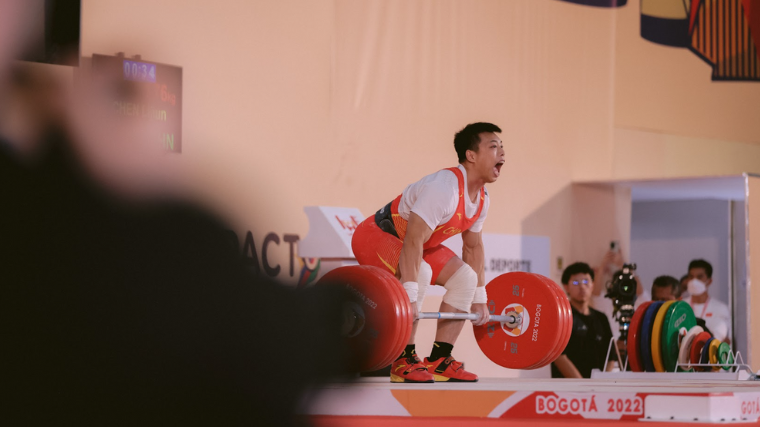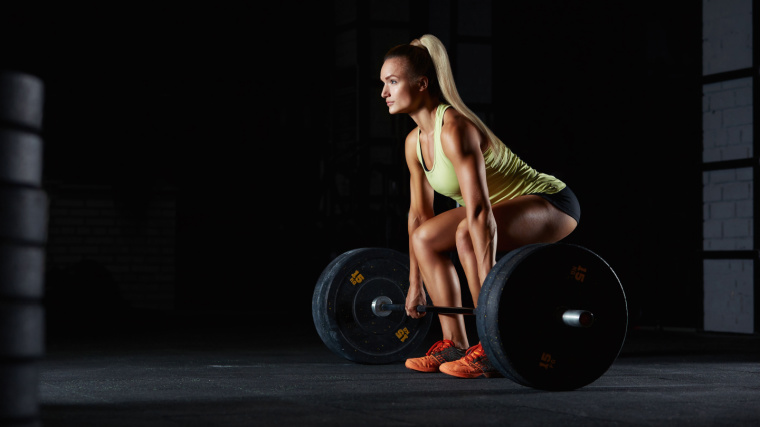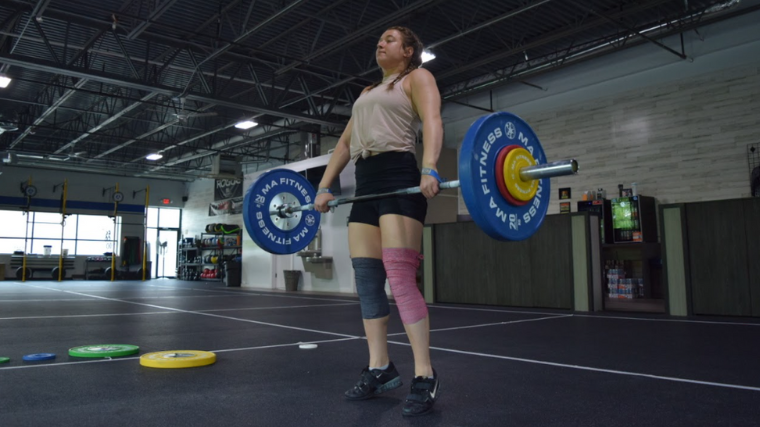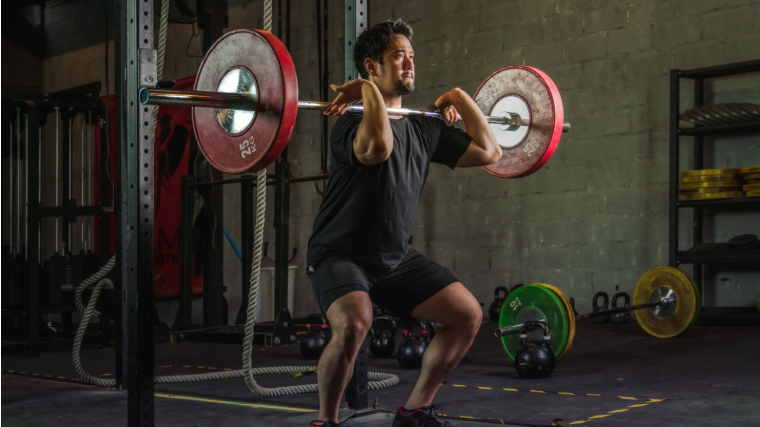[ad_1]
The first time you ever saw someone doing a clean probably blew your mind. Most free-weight exercises are slow and controlled; take a bar (or pair of dumbbells) from here to there with a nice, consistent tempo. The clean, though? Over in the blink of an eye.
And that’s without even mentioning how bizarre the front rack position looks if you’ve never seen it before. The clean — in which an athlete lifts a barbell from the floor up to their shoulders in one swift motion — is an essential skill in the sport of weightlifting (alongside its counterpart movement, the jerk).

It’s also a damn good way to build explosive power, improve and refine bodily coordination, and have a blast in the weight room, to boot. Cleans can be deceptively tricky to learn, especially if you’re teaching yourself, but a good guide can get you there. This is a good guide — here’s how to do the clean.
How to Do the Clean
Before you dive in: The clean refers to a specific bodily motion of “flipping” an object up to your shoulders. It, by default, begins on the floor and is performed with a barbell and bumper plates.
However, the skill of cleaning itself is something you can apply to just about anything you can find in a weight room, including dumbbells, kettlebells, specialty barbells, a sandbag, or even a medicine ball. This guide will teach you how to perform the clean with a barbell from the floor.
If you have them, a pair of weightlifting shoes will go a long way toward mastering the clean from the get-go.
Step 1 — Find Your Setup

The starting position of the clean is similar (but not identical) to the deadlift. Stand with your feet under your hips, about an inch or two away from the barbell. Squat down until you can grab the bar with a close, double-overhand grip.
Allow your knees to come forward in front of the bar until your shins gently make contact with it. Your hips should be slightly higher than your knees and your shoulders should be directly atop the bar or slightly in front of it. That’s your starting position.
Coach’s Tip: Distribute your weight evenly across your entire foot; don’t sit back on your heels for the clean.
Step 2 — Push, Hard

Once you’ve established a solid starting position, initiate the clean by pushing into the floor with your legs — the same way you’d engage your quads during a leg press. Your knees should extend and move out of the path of the barbell as it comes off the floor and glides close to your thighs. Your torso angle should not change as you lift the bar.
Coach’s Tip: Your shoulders should remain stacked on top (or in front of) the barbell as you push. Don’t sit back.
Step 3 — Extend Up

Once the bar reaches mid to high-thigh, engage triple extension by forcefully snapping your lower body; contract your glutes to extend your hips, your quads to extend your knees, and drive your toes into the ground to extend your ankles.
Maintain a relaxed grip and loose arms, allowing the barbell to freely elevate upward in space.
Coach’s Tip: Triple extension is a jump without jumping. Think about aggressively making yourself tall at the top to extend your legs.
Step 4 — Flip and Rack

After just a brief moment at the top of your second pull (that’s when your legs are fully extended), drop your hips down while lifting and planting your feet wider than your starting stance.
This is called the third pull, or pull under, of the clean. As the barbell moves upward in space, move your own body down such that you meet it midair. Flip your elbows down and around to catch the bar in a front rack position and then sink down into a front squat. When you hit the end of your range of motion, push with your legs to return to a standing position with the barbell resting between your neck and your front delts.
Coach’s Tip: Foot movement is optional during this portion of the clean, but most athletes need to squat with a wider stance than they use to pull.
Clean Sets and Reps
Despite being part of the two-exercise biathlon that is Olympic lifting, the clean itself is a fairly versatile movement. Some people train for maximal strength by cleaning in sets of one to three reps, while others string together many reps at a time to improve their conditioning. Here are a couple of different programming options for the clean:
- When You’re Learning: Try as many as 5 to 8 sets of 3 reps with the empty bar and as much rest as needed.
- For Total-Body Strength: Do 3 to 5 sets of 2 to 3 reps with a heavy weight and plenty of rest.
- To Improve Endurance: Try stringing together 8 to 10 reps for 3 to 4 sets with a light weight and limited rest.
Common Clean Mistakes
The clean has more moving parts to it than just about anything you’d do with a barbell. That means plenty of opportunities to fumble the technique or develop bad habits along the way. Be mindful of these pitfalls and you’ll climb higher, faster, in the clean.
Trying to “Muscle It”
Understanding the role your arms and upper body play in the sport of weightlifting is one of the most challenging aspects of the learning process, especially for newcomers. You do physically place the bar onto your shoulders with your arms when you clean, that much is true.
However, the power, force output, and momentum all come from your lower half. You can’t perform a reverse biceps curl with nearly as much weight as you can properly clean if you know how to use your legs. Focus hard on letting go of the idea that you pull with your arms during the clean and the lift will quickly become intuitive.
Hips Rising Early
The clean is not a deadlift. It involves more leg drive and less contribution from your posterior chain. If you aren’t used to performing a from-the-ground pull in this fashion, you’re likely to rely too much on your lower back, glutes, and hamstrings.
This tends to take the shape of your hips popping up as soon as the bar breaks the ground as you shift into a posture that resembles how you’d do a conventional deadlift. Doing so reduces your ability to utilize your quads and can throw your mechanics off-balance as you approach the top of the clean. Make sure to keep your butt down — your hips and shoulders should rise at the same rate.
Kicking the Bar
The snatch, clean & jerk, and all of their variations share one essential technical principle: you need a tight, vertical bar path. “Kicking” the bar refers to a form of deviation from this goal in which you somehow force the bar forward instead of up.
During the clean, this tends to happen because the athlete slams their thighs or hips into the bar to generate momentum, rather than allowing the force produced by proper extension to move the bar.
Kicking the bar out in front tends to create a chain reaction of bad habits. You may have to jump forward to catch it, the bar may not elevate high enough in the first place, and much more. Take care and assess your bar path from the side. If you catch the barbell with your feet in front of where they started, you may need to readjust.
Incomplete Front Rack
If you’ve never held a barbell in the front rack position before, you’ll likely find it difficult or uncomfortable on your shoulders, elbows, or wrists. As such, there’s a good chance that you don’t bring your elbows up fully when you perform the clean.
A proper front rack position stabilizes the barbell between your neck and shoulders. Your arms bear very little weight; your thoracic spine and core are the structures that take the load. However, if you can’t get your elbows up high enough, the weight of the barbell will fall on your wrists, forearms, and shoulder girdle instead.

If this applies to you, work on your mobility before attempting to clean anything heavy. Stretch out your lats, triceps, and wrists in particular.
Clean Variations
There’s more than one way to skin a cat. When it comes to the clean, there are many, many different ways to get the barbell where it needs to be. Most clean variations involve adjusting your stance or posture in some way. Here are a few popular variations of the clean to try for yourself:
Power Clean
In weightlifting (or any other context in which you’d find the Olympic lifts, such as CrossFit), the “power” moniker refers to the height at which you catch the barbell. Racking your cleans in a partial squat with your hips higher than your knees counts as a power.
Power cleans prohibit you from dropping into a front squat. This limits the amount of weight you can use, but also makes the exercise easier to learn. You’ll often see athletes perform power cleans instead of cleans, as mastering the explosive force generation from the pull is more relevant to most sports than sinking into a deep front squat.
Hang Clean
The hang position refers to starting any Olympic lift — or any variation therein — from a standing position instead of the floor. To do a hang clean, then, you’d stand up with the barbell, hinge over, stop your descent at a specific point, and then clean.
The hang clean allows you to work with heavy weights without having to learn the intricacies of pulling from the floor. It also adds some eccentric muscular tension to the clean, which is an essential component of muscle growth.
Muscle Clean
The muscle clean is more of a technical drill than a legitimate variation of the clean itself. While good clean technique necessitates leaving your upper body and arms at the door, muscle cleans flip the script and require you to pull with your arms.
After you reach the top of your extension during the muscle clean, you follow through by actively pulling the barbell into the front rack position with your arms. Weightlifters rely on this drill to remind themselves how to pull themselves down to the bar during a max-effort lift. You can also use muscle cleans as a way to warm up your upper body at the start of your workout.
Clean Alternatives
The clean has a lot to offer. You can use it to gain strength, develop your power output potential, break a sweat, and much more. However, the technical intricacy of the Olympic lifts can be more trouble than it’s worth sometimes.
Clean Pull
Cleans are complicated; clean pulls are fairly straightforward. Olympic lifters perform “pulls” to drill, well, the pull portion of a given movement. You can go for the clean pull if you want to reap the strength and power-related benefits of the clean but don’t have a use case for the second half of the exercise.
This is a great workaround if you have severely limited mobility in your wrists, shoulders, or hips. Clean pulls also let you lift much heavier; all you have to do is break the bar off the floor, hit a snappy extension, and then let the bar go. No catching or squatting.
Jump Squat
Certain exercises are fantastic for power development. The clean certainly falls into that bucket, but it isn’t the only way to get a bit more juice out of your lower body. If you don’t want to do the clean proper, you may want to give the jump squat a go instead.
The nuts and bolts are the same; the execution of a jump squat is really quite similar to how you’d extend during a clean. Allowing the bar to rest statically on your back, rather than in your hands, removes an element of instability and lets you focus on using your quads and glutes.
Pendlay Row
Clean pulls aren’t a back-exclusive movement (though they will absolutely trash your upper back along the way). If you want an explosive stimulus for your posterior chain without having to undergo the learning process of the clean, go for the Pendlay row instead.
Named after renowned Olympic lifting coach Glenn Pendlay, this exercise is similar to the barbell row save for one specific difference: You hinge down, row the bar off the floor as hard as possible, and let it free-fall back to the floor between reps.
The absence of a controlled eccentric phase allows you to focus intently on bar speed and explosiveness above all.
Muscles Worked by the Clean
The list of muscles that aren’t affected by the clean is much shorter than the list of muscles that are. Getting a loaded bar from point “A” to point “B” is one thing; doing it explosively requires more muscles. Here are the major players that affect your performance in the clean.
Back
The clean is, fundamentally, a back exercise, at least in terms of which part of your body receives the most overall muscular engagement. Your back may not generate the power needed to move the bar, but you can think of your back as the framework that enables you to channel muscular power.
Your lower back, lats, traps, and rhomboids all contract isometrically to stabilize your spine as you move through the phases of the clean. If these muscles do not possess the requisite strength to resist the barbell, your technique will suffer.
Traps
Your trapezius muscles are the only muscles in your back that actively flex or extend during the clean. At the top of your second pull, when your body is rigid and extended, shrugging your shoulders can help give the bar a bit more air time.
Quads
Your quads are the single most important muscle during the clean. Rapid, forceful knee extension — something only your quadriceps can provide — will generate the majority of your vertical force production.

This doesn’t necessarily mean that the clean is a good way to grow your quadriceps, but weak quads will spell disaster for a heavy clean attempt. This is something you’ll notice if you find yourself pinned in the bottom of the squat, as pulling the bar off the ground is only half the battle.
Glutes
Your gluteal muscles are the largest and most powerful muscles in your lower body. However, your hips extend horizontally in space. This is at odds with the vertical force output required for a good clean.
That said, violent hip extension provided by contracting your glutes still contributes to proper triple extension. You don’t want to thrust your hips forward when you clean, but you should make an effort to contract your glutes.
Core
Like any compound barbell exercise, a good clean requires strong abdominals and obliques. This is true during the pulling phase when you have to keep your spine rigid and is equally important during the recovery phase when you attempt to stand up with the bar racked in front.
During the recovery portion of the clean, a weak or underdeveloped core puts you at risk of collapsing your torso, putting you in a no-win scenario: If your core can’t keep your torso upright, the barbell will slide out of the rack position and you’ll miss the lift.
Benefits of the Clean
The clean is good for lower-body power development. You need to know how to clean if you want to practice the sport of weightlifting. Heavy cleans turn heads in most gyms. The list goes on (and on) — here are the major benefits of the clean.
Lower-Body Power
The Olympic lifts are valued in collegiate athletics training for their power potential. Track athletes, football players, soccer players, swimmers, and more all perform variations of the two Olympic lifts on a regular basis.
Weightlifting also has a mountain of scientific evidence behind its potency for increasing muscular power, particularly in contexts like maximal vertical jump height. (1) Some data offers that movements like the clean are just as effective as plyometrics for improving lower-body power, (2) so you can pick whichever is more fun for you.

Regardless, the bottom line is that the clean is a phenomenal way of boosting both general athleticism and power output.
Efficient Muscular Stimulation
If you don’t have all day to toil away in the weight room, you need time-efficient movements that get the job done. Niche exercises that develop or stimulate only one quality (think cable or machine isolation moves) aren’t of much use to you if you’re on the clock at the gym.
Conversely, cleans cover a lot of different bases at once. They help you improve your power output, stimulate your entire posterior chain, and are a great conditioning tool as well. They do have a steep learning curve which can take up plenty of time, but once you’re comfortable with the technique, you can save a lot of time by putting cleans center-stage during your workouts.
Essential for Weightlifting
The clean is, literally, one-third of the entire sport of weightlifting. Weightlifters perform the clean & jerk in competition — if you can’t get the bar racked on your shoulders in the first place, you can’t get it overhead.
This technicality places even more importance on the clean. You can have all the strength and coordination in the world to jerk world-class weights overhead, but it won’t mean anything at a weightlifting meet if you can’t clean well.
A Useful Gym Trick
Say you’re performing a barbell-only workout in the squat rack. You’ve just wrapped up a set of upright rows and want to do the barbell overhead press right after. You can work with about the same weight in both exercises.
It’s tedious to unload your barbell, clumsily hoist it up to the hooks of the squat rack, and then load the plates again. If you know how to clean, you can swiftly and safely move the bar from the safety bars (or floor) up to shoulder height. This comes in handy more often than you’d think and can save you a bit of time in the weight room
Who Should Do the Clean
You don’t have to be a weightlifter to make the clean a mainstay movement in your training. Athletes and general gymgoers alike stand to gain quite a bit by cleaning on a regular basis.
Olympic Lifters
There’s no argument to be had here. If you want to train for the sport of weightlifting, you need to know how to clean. That said, you don’t have to perform full cleans; you can power clean in a weightlifting competition without being flagged by the judges. This will limit how much weight you can ultimately lift, but you can get by.
CrossFitters
CrossFit programming draws heavily on weightlifting at all levels, from entry-level workouts all the way up to the Games. Proficiency in the clean will pay dividends on a regular basis if you’re into CrossFit, even if you aren’t asked to perform the clean itself in a given session.

If you have a strength reserve in the clean, your power or hang cleans should be that much easier. The motor pattern is also relevant for sandbag or medicine ball work.
Athletes
Track, field, or court sports all require many of the qualities the clean develops. That said, learning to clean well enough to receive those benefits in the first place constitutes a substantial time investment.
If you play a non-barbell sport and want to improve your power in the weight room, definitely give the clean a go — if you have the time to learn it properly. If not, you’ll have more success with a less-intense variation, such as power cleans or hang cleans.
Clean Up Your Game
Cleans are cool. If that’s not enough of a reason to pick up a barbell and start learning them, maybe you need more muscular power. Or a stronger back. Or want to break a sweat without touching a treadmill.
Clean up your clean technique and these benefits (along with many more) are yours for the taking.
FAQs
It’s perfectly normal to feel a bit spun out by the Olympic lifts. If you’re still scratching your head over some aspect of the clean, look no further.
Why is it called a clean?
Weightlifting has undergone several changes to its rules and format. Originally, athletes were required to lift a barbell from the floor up to their shoulders without it touching their bodies at any point. They had to lift it cleanly, hence the name. This stipulation is no longer relevant in the sport, but the movement has retained its original namesake regardless.
Is the clean bad for my wrists?
The front rack position may look visually dangerous, but in practice and with proper mobility, isn’t harmful to any joint in your arms or shoulders. That’s because there’s no actual load placed upon your wrists when you catch a clean. The bar rests comfortably on your torso, while your fingers gently clutch it.
References
- Tricoli, V., Lamas, L., Carnevale, R., & Ugrinowitsch, C. (2005). Short-term effects on lower-body functional power development: weightlifting vs. vertical jump training programs. Journal of strength and conditioning research, 19(2), 433–437.
- Teo, S. Y., Newton, M. J., Newton, R. U., Dempsey, A. R., & Fairchild, T. J. (2016). Comparing the Effectiveness of a Short-Term Vertical Jump vs. Weightlifting Program on Athletic Power Development. Journal of strength and conditioning research, 30(10), 2741–2748.
Featured Image: Jules43 / Shutterstock
[ad_2]
Source link
Fitnessnacks – #Clean #Explosive #Power #Muscle #Growth
Courtesy : https://barbend.com/how-to-do-the-clean/
